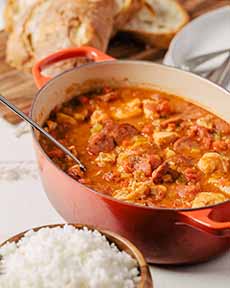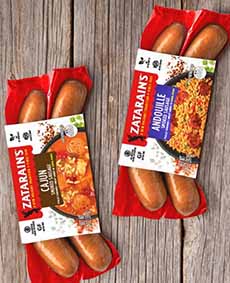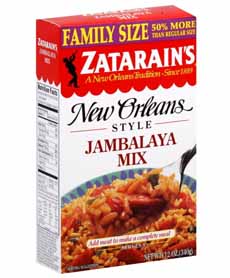Jambalaya Hot Dog Recipe For National Hot Dog Month
|
|
National Hot Dog Day is the third Wednesday in July, but the entire month is National Hot Dog Month. Continuing with more of our 30+ enticing hot dog recipes, here’s a Jambalaya Hot Dog. Thanks for the recipe go to Chef Kevin Belton and Zatarain’s, a food company based in New Orleans. Zatarain’s makes a large family of products with seasonings and spices that are part of the cuisine and cultural heritage of New Orleans’ Creole and Louisiana’s Cajun traditions. The Jambalaya Hot Dog recipe is below, and you can visit Zatarains.com for more recipes and product information. We’ve published lots of hot dog recipes over the years, but this new one combines the all-American dog with the all-NOLA jambalaya. It will add to your summer and year-round—enjoyment of hot dogs. During Mardi Gras, you can add it to your recipe repertoire. The jambalaya is easy to make with a box of Zatarain’s Original Jambalaya Rice Mix and their Andouille Smoked Sausage and Cajun Style Sausages. But wait, you say: sausages are not hot dogs. That’s true based on how the terms are used in the U.S. However, “sausage” is an umbrella category and hot dogs are in fact a types of sausage, as are brats (bratwurst), chorizo and many other types of sausage. (Here’s a comprehensive list of sausages worldwide.) So we know you’ll overlook the technicality, and enjoy Zatarain’s yummy sausages in a hot dog roll. Can you substitute a regular American hot dog? It won’t be as spicy, but go for it! Jambalaya is a rice dish that originated in Louisiana. Creole jambalaya, called red jambalaya by the Cajuns, sprang from the French Quarter of New Orleans, the sector originally inhabited by Europeans. Jambalaya was an adaptation of paella by the Spaniards with white rice instead of saffron rice. Most of the Spanish in New Orleans could not afford saffron due to high import costs. Tomatoes were substituted to color and flavor the dish. French Creoles introduced jambalaya to the Cajuns of southern Louisiana, who rarely used tomatoes (it’s swamp country). Instead, they browned the meat for color and smoky flavor; the Creoles referred to that recipe as brown jambalaya. The word “jambalaya” is a combination of the Spanish jamón or the French jambon, meaning ham, and another word—however, what word that is can be controversial. Jam-paella or jamb-paella = jambalaya. While there are different recipes for each dish, both paella and jambalaya incorporate chicken, ham, sausage and seafood. Since jambalaya could be made economically in big black cast iron pots for crowds, it became popular for large events, including church suppers, weddings and political rallies. Here are some jambalaya recipes. Ingredients For 4 Servings 1. PREPARE the jambalaya as directed on the box, using Zatarain’s Smoked Andouille Sausage as the “meat of choice.” Quarter the sausages lengthwise and then cut into quarter-inch cubes. Add to the jambalaya mixture as directed. Brown in oven, on grill or stovetop as preferred. 2. USE Zatarain’s Cajun Style Smoked Sausage for the sausage dog. Skewer from one end to the other, and using a paring knife, spiral cut the sausage entirely at a 1/3-inch thickness (if this is a challenge, leave the whole sausage as is). Grill to desired crispiness. 3: ASSEMBLE: Place half of the the spiraled link onto buns and smother with jambalaya. Garnish with scallions and serve. Man has been stuffing seasoned ground meat into intestine casings at least since Ancient Greece. (Today, synthetic casings are the norm.) Homer’s Odyssey, believed to be written in the 8th century B.C.E., mentions a blood sausage. The cleaned intestines of the animal produce the characteristic cylindrical shape. Sausages are among the oldest of prepared foods [source]. Some cured or smoked sausages can be stored without refrigeration. Most fresh sausages must be refrigerated or frozen until they are cooked. |
|
|
Sausages are made in a wide range of national and regional varieties, which differ by the types of meats that are used, the spices and other flavorings, and the manner of preparation. Ingredients such as breadcrumbs or grains may be included as extenders. Sausages are sold both pre-cooked and raw, where they can be broiled, grilled, pan-fried, steamed, etc. The word “sausage” first appears in English in the mid-15th century, spelled sawsyge. The word came from Old North French saussiche, which evolved to the modern French saucisse). The French word, in turn, came from Vulgar Latin salsica (sausage), from salsicus, meaning seasoned with salt.
|
||








